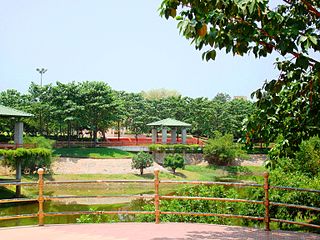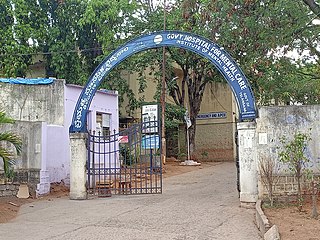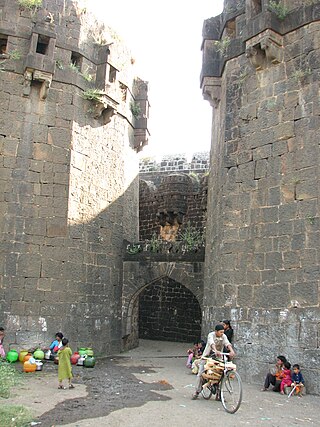
Hyderabad State was a princely state in the Deccan region of south-central India with its capital at the city of Hyderabad. It is now divided into the present-day state of Telangana, the Kalyana-Karnataka region of Karnataka, and the Marathwada region of Maharashtra in India.

Nizam of Hyderabad was the title of the ruler of Hyderabad State. Nizam is a shortened form of Niẓām ul-Mulk, and was the title bestowed upon Asaf Jah I when he was appointed Viceroy of the Deccan by the Mughal Emperor Farrukhsiyar. In addition to being the Mughal Viceroy (Naib) of the Deccan, Asaf Jah I was also the premier courtier of the Mughal Empire until 1724, when he established an independent realm based in Hyderabad, but in practice, continued to recognise the nominal authority of emperor.

Asaf Jah VI, also known as Sir Mir Mahboob Ali Khan Siddiqi, was the sixth Nizam of Hyderabad. He ruled Hyderabad State, one of the princely states of India, between 1869 and 1911.

Mir Osman Ali Khan, Asaf Jah VII was the last Nizam (ruler) of Hyderabad State, the largest state in the erstwhile Indian Empire. He ascended the throne on 29 August 1911, at the age of 25 and ruled the State of Hyderabad between 1911 and 1948, until the Indian Union annexed it. He was styled as His Exalted Highness (H.E.H) the Nizam of Hyderabad, and was widely considered one of the world's wealthiest people of all time. With some estimates placing his wealth at 2% of U.S. GDP, his portrait was on the cover of Time magazine in 1937. As a semi-autonomous monarch, he had his mint, printing his currency, the Hyderabadi rupee, and had a private treasury that was said to contain £100 million in gold and silver bullion, and a further £400 million of jewels. The major source of his wealth was the Golconda mines, the only supplier of diamonds in the world at that time. Among them was the Jacob Diamond, valued at some £50 million, and used by the Nizam as a paperweight.

Hyderabadi biryani is a style of biryani originating from Hyderabad, India made with basmati rice and meat. Originating in the kitchens of the Nizam of Hyderabad, it combines elements of Hyderabadi and Mughlai cuisines. Hyderabad biryani is a key dish in Hyderabadi cuisine and it is so famous that the dish is considered synonymous with the city of Hyderabad.

The Nizam College is a constituent college of Osmania University established in 1887 during the reign of Mir Mahbub Ali Khan, Asaf Jah VI, in Basheerbagh, Hyderabad, Telangana.

Osmania Medical College, formerly known as Hyderabad Medical School, is a Government medical college in Hyderabad, Telangana, India. It was founded in 1846 by the 5th Nizam of Hyderabad and Berar, Afzal ud Dowla, Asaf Jah V. The college was originally affiliated to Osmania University system, now it is affiliated to the Kaloji Narayana Rao University of Health Sciences, and the Osmania General Hospital. After the establishment of the Osmania University in 1919, the school was renamed Osmania Medical College, after the seventh Nizam of Hyderabad, Mir Osman Ali Khan. The college was 48th in the 2024 National NIRF Medical University Rankings. and also an ISO Certified Institute.

Sultanzade Nizam Mir Barkat Ali Khan Siddiqi Mukarram Jah, Asaf Jah VIII, less formally known as Mukarram Jah, was the titular Nizam of Hyderabad between 1967 and 1971. He was the head of the House of Asaf Jah until he died in 2023.

The Jewels of the Nizams of Hyderabad State are among the largest and most expensive collection of jewels in present-day India. The jewels belonged to the Nizams, rulers of Hyderabad State. After the annexation of their kingdom by Union of India, the Nizam and his heirs were barred by the Indian government from taking the collection, claiming that it was a national treasure. After much litigation, the diamond was purchased by the Government of India from the Nizam's trust for an estimated $13 million in 1995, along with other jewels of the Nizams, and is held at the Reserve Bank of India vaults in Mumbai.

King Kothi Palace or Nazri Bagh Palace is a royal palace in Hyderabad, Telangana, India. It was the palace where the erstwhile ruler of Hyderabad State, Sir Mir Osman Ali Khan, the seventh Nizam, lived. It was a palace bought by his father Mahboob Ali Pasha, who had a penchant for buying ostentatious homes.

The Asaf Jahi was a Muslim dynasty that ruled the Hyderabad State. The family came to India in the late 17th century and became employees of the Mughal Empire. They were great patrons of Indo-Persian culture, language, and literature, and the family found ready patronage.

Sir Viqar ul-Umara, Iqtidar ul-Mulk, Iqbal ud-Dowla, Secundar Jung, Nawab Muhammad Fazl-ud-din Khan Bahadur, was the Prime Minister of Hyderabad State from 1893 to 1901, and also served as the Amir-e-Paigah from 1881 to 1902.

Errum Manzil or Iram Manzil is an expansive palace standing in Hyderabad, Telangana, India. It was built around the year 1870 by Nawab Safdar Jung Musheer-ud-daula Fakhrul Mulk, a nobleman of Hyderabad state. It is located on top of a hillock off the Khairatabad - Panjagutta road.

Sanathnagar is an industrial and residential neighbourhood in Hyderabad City, Telangana, India, and one of the most densely populated neighbourhoods in India.

Erragadda is a developing commercial and residential area in the west zone of Hyderabad, Telangana, India. It is home to the ECE Industries, an electrical enterprise. Popular landmarks are the Gokul theater and St. Theresa's Hospital which was constructed in the 1980s or 1970s respectively. It is administered as Ward No. 101 of Greater Hyderabad Municipal Corporation. The corporator is shaheen begum.

The Institute of Mental Health, Erragadda also known as Erragadda Mental Hospital is one of the oldest health institutions established by the Nizams reign in Hyderabad State. It is run by Government of Telangana, located in Erragadda, Hyderabad. It serves the mental health patients from all over the state.
Hyderabad is the capital of the Indian state of Telangana. It is a historic city noted for its many monuments, temples, mosques and bazaars. A multitude of influences have shaped the character of the city in the last 400 years.

Naldurg Fort is a historic fort in Naldurg town of Dharashiv district in Maharashtra state of India. Naldurg Fort is named after Nalraja who built the fort in medieval architectural style. The unique feature of the fort is that it encloses a knoll of basalt rock which juts out into the valley of the small Bori River and a long fortification wall with many bastions. The Naldurg fort is one of the important ground forts in the Marathwada region.
The localities and neighborhoods of Hyderabad have unique oral histories, dating to the time of the Qutb Shahi dynasty, over 400 years ago, and are named after various people and things. Some are named after a major building or structure in the locality, others named for individuals. The names are mostly in Telugu and Urdu, the widely spoken languages of the city. List of localities, neighborhoods and streets of Hyderabad and their etymology include:

A distinct Indo-Islamic architecture style with local contribution is reflected in the historical buildings of Hyderabad, making it the first and "Best Heritage City of India" as of March 2012. The city houses many famous historical sites constructed during Qutb Shahi and Asaf Jahi period, including various mosques and palaces.


















